11 checks to make before your classic’s first spring drive
With warmer weather finally arriving in many parts of the country, spring driving season is once again upon us. This article originally published in 2020, but these checks were as relevant then as they are today. Here’s to many more miles this year! –Ed.
If you’re reading this, you almost certainly have a non-daily-driven enthusiast car somewhere in a locked garage. It’s time to unlock the door, let that puppy out, fire it up, and drive it.
But you need to check a few things first.
I assume that the car has been sitting over the winter—say, three to six months. If the car’s been sitting for years instead of months, you get into a whole other level of issues like bad gas, clogged fuel lines, corroded cooling-system components, and failed brake and clutch hydraulic seals. But for a season’s sit, the list below should be pretty good.
Enabling the rollout
The cars that I store offsite are in rented, traditional, one-car-per-roll-up-garage-bay spaces and thus can be brought out at a moment’s notice, but at my house I have a shoebox-proportioned garage with a single door into which four cars are stuffed in two rows, nose-to-tail.
The car immediately behind the door can be pulled out easily, and the one behind that (on the mid-rise lift) is next in line, but the other two are typically blocked in by a winter’s worth of tools and parts.
Once that Maginot Line is cleared, I need to slide a car to the right on wheel dollies. This turns my space from a four-car, winter garage to a three-car, three-season garage, which it remains until first snow. It also means that one formerly garaged car must go somewhere, creating a chain reaction that sets off a shuffle in the other places where I store cars.
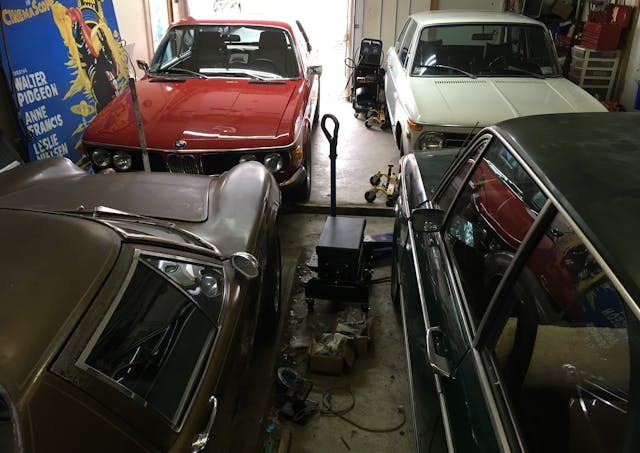
Tires
If, when you roll open the garage door for the first time in months, one of your car’s tires is wheel-on-the-cement flat, you kind of have to start with the tires, so let’s. Obviously, if that’s the case, you need to air that tire up before you can move the car. If you don’t have an air compressor in the garage, buy a portable one that runs off the cigarette-lighter socket, or better yet, runs off 12V DC or a 120VAC adapter.
I’ll air up the tire and then see what it’s going to do. If you immediately hear it hissing from a puncture or a bad valve stem, then you need to stop everything, jack up the car, pull the wheel off, and either swap on another wheel and tire or get this one fixed. But if you don’t, you can see whether the leak deflates the tire over hours or days. Just remember that it deflated over the winter, so it’s going to do it again.
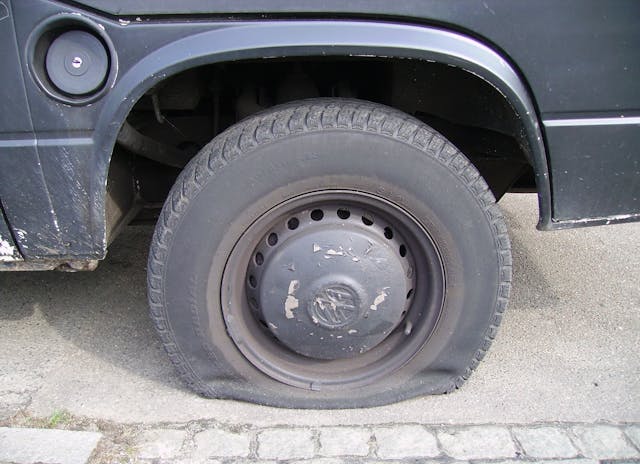
Then, check the air pressure of all four tires. While you’re doing that, it’s a good idea to inspect the tire sidewalls for cracking. Odds are that if the car is stored indoors, the tires aren’t going to get much worse over a single winter, but it’s easy for 10 years to go by one winter at a time and the tires to cross from old-but-OK to sheeh-I-don’t-want-to-drive-farther-than-to-the-gas-station-on-those.
Battery
We’ll come back to the battery in cranking (below), but here’s where I talk about what you should’ve done when you put the car away last fall. If the battery has been on a tender or trickle-charger for the winter, it’s probably fine. Since I store several of my cars in a remote garage without electricity, I can’t trickle-charge them, so instead I simply unhook the negative battery terminal over the winter. Most of the time, when I reconnect it three or four or six months later, the engine turns right over.
But if you didn’t do either of these things, you’ll probably have a problem.
You can take a multimeter, set it to measure voltage, and put the two probes on the battery terminals. If it reads 12.6 volts, or near it, the battery is fully charged, and if it’s in good health and the cable connections are good, it should turn the engine over. But with every 0.2-volt drop, the battery loses about 25 percent of its cranking power, so if it’s reading closer to 12 volts than 12.6, it’s is unlikely to crank the engine over without being connected to a good three-stage charger for several hours. So measure the battery’s voltage, and if you need to charge it, charge it.

Fluids inside
Check the oil, coolant, and brake fluid levels. I’m pretty bad at keeping track of which car had an oil change when, so I do it more by the seat of my pants. If the oil looks black, I make a note to change it soon. I give a quick look inside the radiator or expansion tank to both check the level and see if there’s any oil in there indicating a weakening head gasket.
Fluids outside
Next, look under the engine compartment for evidence of leaks. Hopefully all you find is a few dots of oil from where the car’s been leaking out the front timing cover for the last 40 years and nothing more.
Anything green is antifreeze, and its source should be identified before you drive the car, as a minor leak can quickly mushroom into a gusher. Blue liquid can be either antifreeze or washer fluid. Clear liquids are usually power steering or brake fluid. I’m not above doing the pinky-in-the-fluid-and-tongue-touch-to-the-pinky test (antifreeze is sickly sweet), but I’m old and cannot be easily killed.
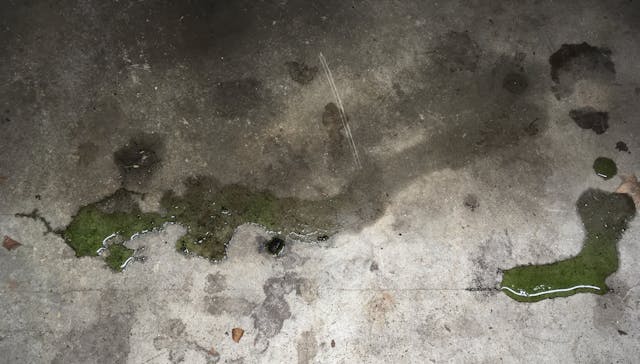
Move to the back of the car where the fuel tank is, schooch under, look, and sniff. Vintage cars have metal fuel tanks, and they can leak from age, particularly with ethanol’s propensity for attracting water. Since it’s good practice to store a car with a full tank of gas (this eliminates the chance for humid air to get into the tank and contaminate the gas with water), if you find the tank leaking, it ruins your day, since you now need to drain it. Gas can also leak from rotted or cracked rubber fuel lines.
Gasoline isn’t like oil or antifreeze; there should be a zero-tolerance policy for any amount of fuel leakage. You should also sniff in the engine compartment to be certain gas isn’t leaking there.
The critter check
If your garage has an affinity for rodents and they’ve made your car home, they can deposit a lot of material in the air cleaner in a short amount of time. It’s good insurance to pop the top off the air cleaner and have a quick look.
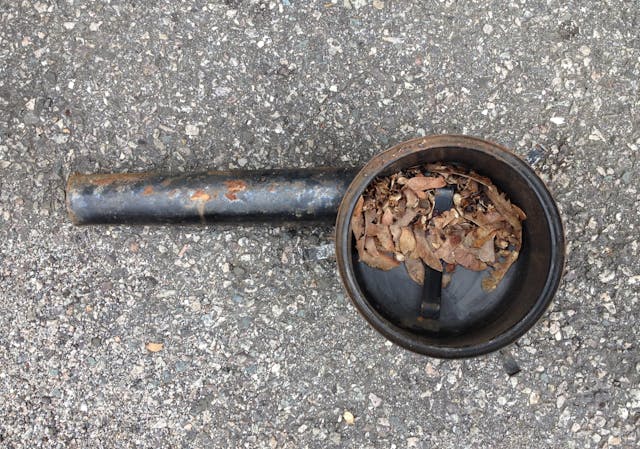
Hoses and belts
Give the hoses and belts a quick inspection. Squeeze the hoses. If any of them are pillowy soft, order replacements. Inspect the belts for cracks and cuts and put a thumb on each of them to check the tension. If they’re obviously loose, take a moment and tighten them.
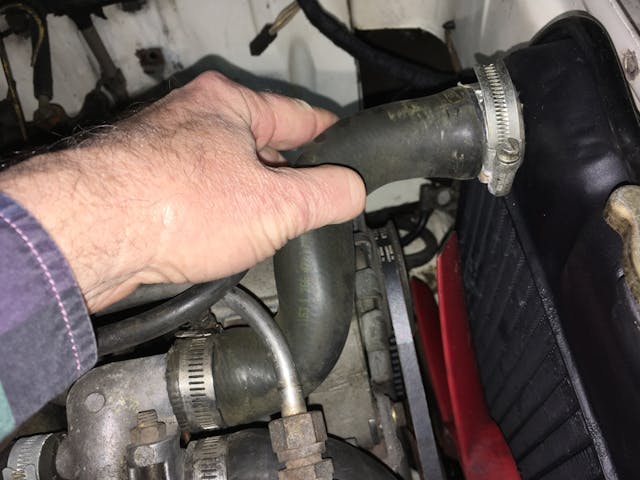
The crank-over
If the car has passed the above checks, the engine is ready to be cranked. As I said above, if the battery is fully charged and registering about 12.6 volts, it should crank when you turn the key. If it doesn’t crank, clean the battery and cable terminals and try again.
If the voltage is a little low, you can jump-start the car, but if the battery is deeply drained (turn the key and you get a click of the starter but that’s all), or worse, flatlined (less than 10.5 volts, or the car’s dash lights barely even turn on), it’s best to replace it before you drive the car. Alternators aren’t designed to charge deeply discharged batteries. Although old analog cars often don’t seem to mind, post-OBDII cars with a proliferation of electronic control modules can do very odd things, including bucking and dying, if a deeply discharged battery is jump-started and the car is driven.
If the car is fuel-injected, it will likely start in just a few seconds when the starter is cranked. If it doesn’t, the fuel pump may not be running, either due to a popped fuse, stuck relay, or the pump itself.
Carbureted cars often take much longer to start due to the lower fuel pump pressure, the need to refill the float bowls, the far less precise air/fuel metering, and the lack of direct spray into the cylinders. A short blast of starting fluid into the carburetor throat can coax the engine to life. If a carbureted car still won’t start after sitting, the problem is often that an old fuel line has become dry-rotted and is sucking air rather than fuel.
The eyeballs-on idle
Once the engine is running, let it idle for about a minute. Then shut it off and look under the engine for any fluid dripping or streaming out.
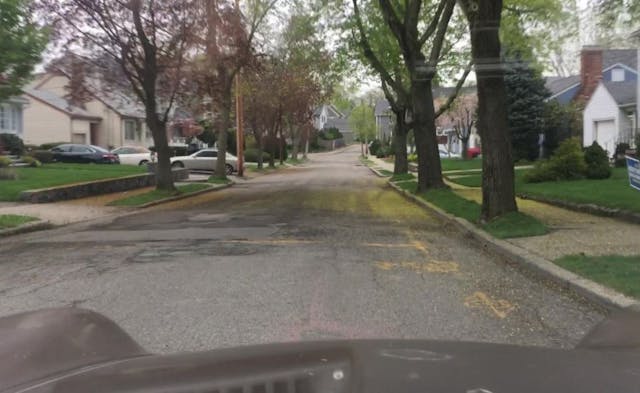
Twice around the block
It’s common for brake pads to stick to rotors from sitting. If the car has been stored indoors, the rotors probably won’t have rusted much, but still you want to scope it out. Take the car for an easy lap around the block. Brake gently to verify that the brake pedal is firm and functional, then more firmly. Pick up speed and do it again. Note any brake-pedal shudder (pulsation), pulling to one side, or steering-wheel shimmy. Pull back into the driveway and check again for any fluid leakage.
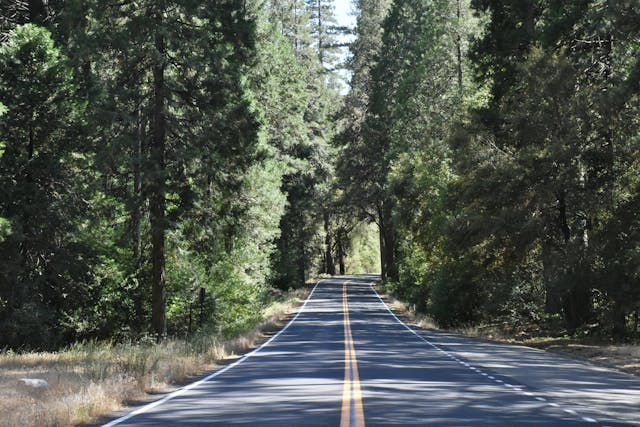
A real test drive
Take the car up onto the highway or other road where you can build speed. Verify that it comes up to operating temperature in about the middle of the gauge and stays there. Continue to test the brakes for shuddering or pulling. If the brake pedal is still pulsating, there are still unwiped deposits on it. A series of hard braking exercises (first verifying that no one is behind you) may wipe the rotors clean, or you may find that it doesn’t go away and you need to buy new rotors.
If there’s steering-wheel shimmy that wasn’t there in the fall, it’s likely the tires are flat-spotted from sitting. It may go away. It may not. Come home, recheck for fluid leakage, and check again the next morning.
If the car passes these tests, I feel pretty good about thinking that it’s in about the same condition it was in when put away in the fall and I’m ready to begin to enjoy it in the spring. But keep in mind that successfully emerging from storage doesn’t mean that the car has been healed of any known problems. Cars are not biological systems; they don’t mend themselves with a good long sleep.
***
Rob Siegel has been writing the column The Hack Mechanic™ for BMW CCA Roundel magazine for 34 years and is the author of five automotive books. His new book, Resurrecting Bertha: Buying back our wedding car after 26 years in storage, is available on Amazon, as are his other books, like Ran When Parked. You can order personally inscribed copies here.
Check out the Hagerty Media homepage so you don’t miss a single story, or better yet, bookmark it. To get our best stories delivered right to your inbox, subscribe to our newsletters.
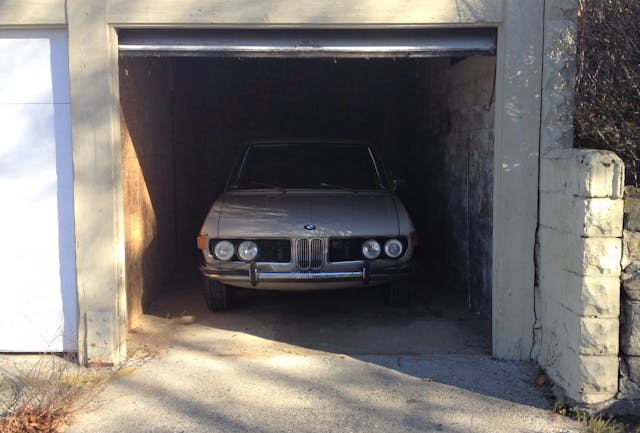


One item that’s oft overlooked (as it is in this column) is the spare tire. Assuming you have one, when you are inspecting and airing the four on the ground, do exactly the same thing to that fifth one. You know, the one that might be REALLY important to you sometime this summer! 😃
This is a great point! Our car group had been taking cruises, etc. when, on an occasion, one of the members came by the house for something. As we looked at his ’69 Beetle, I checked the spare tire–purely flat!!! I said “(name)–when was the last time you put air into this tire?” “Never!”, he told me. Well, I found the tire to be “welded” to the rim. I took the tire to a shop and they had to chisel the tire off and prepare the rim for a new tire. I try to alert our group on all of the things which should be checked prior to a cruise (and even daily maintenance). Thanks for this reminder, DUB6
I believe the washer fluid was powered by air pressure from the spare in old VW’s.
Great advice as always. On my carbureted baby I always put on a battery charger before I crank it over so I can crank the engine for a good few seconds to build up oil pressure before the engine starts. I might be overthinking it a little but those extra few seconds of cranking can’t hurt.
A highly reputable engine builder (Bob Silgfies; Easton, PA) told me not to do that (I had been for years), but to fire the car as soon as one can, as cranking the engine without oil on the cam lobes will grind them down much faster. Firing it will ensure the lobes are lubricated.
No, Adam was right.
i have been doing this procedure for years on my truck never had any issues.
Excellent article Rob! Especially good for those that are more new to owning a hobby oriented cars. Some of us that have been doing this for may years have our own check list. Mine looks much like yours, with a few short cuts like pouring a little bit of fuel down the carb when starting, but that’s for us who are ready for the possible bad consequences. 🙂
Good timing!
when storing run your fuel tank low and put a few gallons of rec-90 ,, ethanol free fuel in your tank ,, ethanol fuels have a much shorter shelf life and are more hygroscopic . test drive to the gas station for fresh fuel , a lot of vehicles use plastic fuel tanks and even fuel lines ,, any vehicle with evap emissions has a closed loop fuel system that will not allow venting to the atmosphere
2 thoughts:
1 – Prime the oil pump? On some of the old American Iron, it isn’t hard to do – pop off the distributor, cut the handle off a long screwdriver, stick it in a drill, and spin it until you see pressure on the gauge (or, if you don’t have a gauge, 15-20 seconds.)
2 – Brakes. I like to jack the car up and have a friend spin the wheels by hand before I step on the pedal, just to see if they’ll stop me at the end of the driveway. Overly cautious? Maybe, but any peace of mind when it comes to old brakes doesn’t hurt.
I think both of these ideas are valid, and I especially like #2 – brake systems can and do have failure points that can happen while in storage. For the rookies: if you do #1 from Perpetually Unimpressed’s suggestions, be sure to mark on the distributor and the manifold so you can get it back in in approximately the same position after the priming. And still, you’d better be prepared to re-time the ignition system, as even small variances in the placement of the distributor can affect timing.
Priming the oil pump after storage is always a good idea. There are many different oil pump drive setups on vintage cars. Many Fords and Mopars have a specific hex drive oil pump, with a camshaft drive coupler that must be removed before priming. More involved than cutting the handle off of an old screwdriver. (although it would probably work on your small block Chevy) . Check with a real mechanic about your particular engine first.
The way I prime the oil system in my Corvair is the way I prime aircraft engines that have been sitting for a long time. I remove the oil pressure line or pressure sensor where it comes out of the engine and pump oil in through the system. When I put the car away for its long winter sleep here in Alaska, I always change the oil and filter just before storage, no matter what the mileage. Fresh oil in the crankcase helps to keep excess moisture and acids and other byproducts of combustion out of the engine during it’s long sleep. When doing the oil change I put in 4 quarts of oil and leave room for the other half-quart required for when I pre-oil in the spring. I then pressure fill the system until it reads full on the dipstick to prevent overfilling the crankcase. By the way I also always skip the antifreeze check.
Rotating an engine with a dry flat tappet cam until oil pressure is finally achieved is probably not a very good idea.
I do the same. Although I keep the wheels off the ground during winter, I have missed the tail tail drops during spring pre-check and hit the brakes during test drive to have nada. Thanks for the reminder too all.
Just pull the wire off the wire and crank for 10-20 seconds. Or it may take that time to fire up anyways
*Coil*
Priming the oil system is a great idea, But if it is a chevy engine, unless you use an old distributor (modified) or a proper priming tool, you are only lubricating part of the engine. The base of the distributor has a groove that connects oil passages in the engine.
Your rollout checks article is EXCELLENT. Thanx for the effort!
THANK YOU Very good From ken from the NASH CAR CLUB
Good advice. I also try to start and run the engine every couple of weeks during winter storage. Start and run about 10 min or so or at least until thermostat opens and heater blows warm. I pump the breaks to lube the seals, turn steering back and forth, and then pull out of garage and back in to roll the tires. Good to do if you have easy access to the car.
good way to attract mice
One thing that I don’t but should do…
Is change the brake fluid every few years.
Dang hygroscopic fluid bs!!! 🙂
There is a flip side to that one, too: after I’d flushed and changed to pure silicone fluid because it won’t hold that moisture, quite by chance we found all the sludgy water-adjacent material from the whole circuit pushed into the piston cavity, and laying around in there waiting for its chance to start trouble. So after you’ve eliminated the bad old fluid, there’s still some bad old fluid to watch out for. It can’t hurt to look, once in a while.
My 63 s22 comet convertible is covered in my driveway all winter. Long as the roads are clear she’s getting a workout… Gotta keep those vital fluids flowing…
I have a ’64 caliente convertible that has only been driven once since I bought it last year, before having to change seals from it sitting from the previous owner. Once I get it fixed, any advice on these cars? I’ve never owned a true convertible (my jeep stays in the garage with no top or doors).
Store it top up. Folded will lead to problems.
The minute I saw the picture of an old six cylinder BMW in a 60’s lockup, I knew who wrote the article. Always nice to come across your work, Rob.
Yep! You nailed it. I don’t think any other writers at Hagerty are courageous (crazy?) enough to drive old BMWs and an old Europa. I notice Rob used a picture taken while driving the Lotus ‘twice around the block’.
Excellent article for checking all areas of the vehicle prior to summer driving. Especially the safety inspection of the brake system. Thank you for sharing your knowledge.
I don’t use fuel with ethanol added in my 74 Grand Prix. Several stations have premium fuel which has no ethanol. Yes, it costs more than regular fuel but worth it to eliminate the problems caused by ethanol in older cars. If you look closely at the gas pumps they display the “ingredients” and octane numbers. Usually 95 or higher octane ratings are ethanol free.
If storing the car in an unheated area without access to a battery charge, you should have removed the batteries and put them in an area that does not get below freezing. If the charge depletes too far, it will freeze. There is a LOT more that should be or should have been done before and after storage than is presented. Those tires that are older than ten years should probably not be driven on, at least not at highway speeds. They may look fine and have good tread, but rubber goes bad with time.
Used dryer sheets really do take of the critter problem. They also keep that musty smell away.